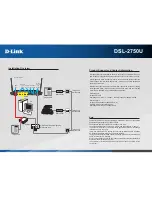
48
route add default 0.0.0.0 192.168.2.7 00:00:00:00 2 # MAN
relay ether ether
relay ether vlane
relay vlane vlane
ipatm lifetime 60
# IP host table:
# Port table:
router 520/UDP
snmp 161/UDP
tftp 69/UDP
telnet 23/TCP
DSL>
ip config save
Updating flash filing system ...
done
ip: configuration saved
3. device
Syntax:
device
device add <i/f> <type> [<file>] [mtu <size>] [<IP address>]
device delete <i/f>
device flush
Description:
Displays the interfaces that IP is configured to use, or adds an interface to the configuration, or
deletes an interface, or all interfaces, from the configuration. However, the commands to change
the configuration do not take effect immediately (except when the “
device add
” command is run
at start-up from the initialisation file). It is necessary to save the configuration (e.g. with “
ip
config save
”) and restart the system (e.g. with “
ip restart
”) before they take effect. “
device
”
will display both the current interfaces and those that have been configured but are not yet in effect.
(Other commands apply only to the devices in effect, rather than to those configured; when adding
a device, for example, one may need to issue the “
device add
” command, then the “
config
save
” and reboot, then issue any other configuration commands that depend on the existence of
the device, and then “
config save
” again.)
“
<i/f>
” is an arbitrary label for the interface, which is used in referring to it in subsequent
commands. (It is often chosen to be the same as “
<type>
”, though this is perhaps slightly
confusing.)
“
<type>
” specifies the class of interface: Ethernet-like, IP-over-ATM, or loopback. For an
Ethernet-like or IP-over-ATM interface, “
<file>
” specifies the file name that will be opened to
access the underlying device. For a loopback interface, “
<file>
” is not used, and can just be
specified as “-“ or omitted altogether.
Several different values of “
<type>
” specify the same class of interface; they differ in that each
implies a different default value for “
<file>
”. As a result, for the most common interface
configurations, “
<file>
” can be omitted, and one need only specify the appropriate value of
“
<type>
”. The supported values for “
<type>
” are
Class
<type>
Default file
Ethernet
ether
//nice
or
//ethernet
or
//edd
vlane
//lane
flane
//lec1
bridge
//bridge
IP-over-ATM
atm
//q93b
atmpvc
//atm
Loopback
loop
-
“
<mtu>
” specifies the MTU (maximum transmission unit); that is, the size of the largest datagram
(excluding media-specific headers) that IP will attempt to send through the interface. The value
specified will be ignored if it is larger than the maximum supported by the interface class, which is
currently 1500 except for the loopback interface, unless the IP-over-ATM MTU has been changed;
normally there is no point in setting the MTU less than this, so the “
<mtu>
” option is of little use.
“
<IP address>
” is the IP address that this system uses on the interface ; if it is not specified, the
interface will be disabled until an IP address is supplied with the “
ip enable
” command. For a
















































